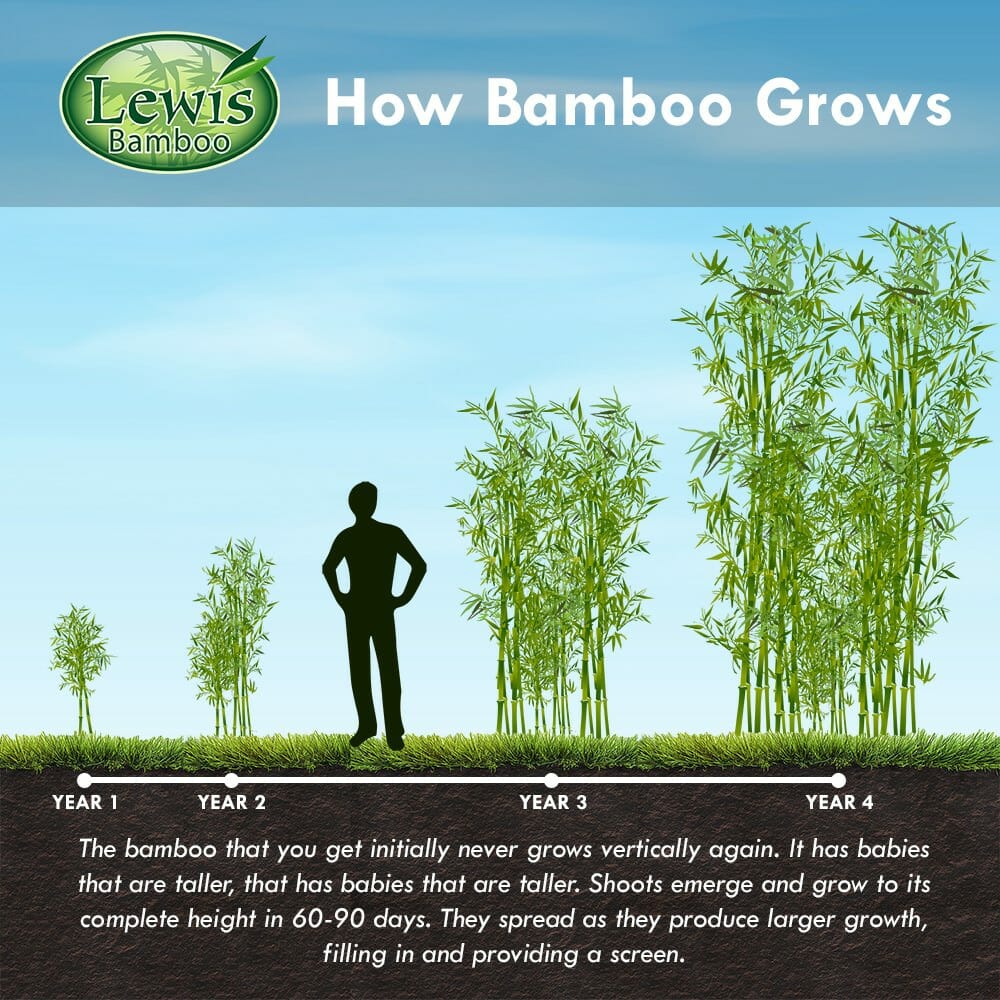Bamboo can grow up to 35 inches in a single day. Its rapid growth makes it one of the fastest-growing plants.
Bamboo’s impressive growth rate is a marvel of nature. This towering grass species can thrive in various climates, making it a versatile choice for gardeners and landscapers. Its ability to grow quickly provides a sustainable resource for construction, furniture, and even culinary uses.
Bamboo’s roots help prevent soil erosion and improve soil quality. This plant’s rapid growth and numerous benefits make it an eco-friendly alternative to traditional wood. Whether you’re interested in its environmental benefits or its practical applications, bamboo’s growth rate is a key feature that captures attention.
Bamboo Growth Basics
Bamboo is one of the fastest-growing plants on Earth. Understanding bamboo growth can help you appreciate its rapid development. Let’s explore the basics of how bamboo grows.
Types Of Bamboo
There are two main types of bamboo: clumping bamboo and running bamboo.
- Clumping Bamboo: Grows in tight clusters. It spreads slowly.
- Running Bamboo: Spreads quickly through rhizomes. It can cover large areas.
Growth Conditions
Bamboo growth depends on several factors. These include soil quality, water, sunlight, and temperature.
| Factor | Ideal Condition |
|---|---|
| Soil Quality | Rich, well-drained soil |
| Water | Consistent moisture, not waterlogged |
| Sunlight | Full sun to partial shade |
| Temperature | Warm climates, but some species tolerate cold |
Ensuring the right conditions can lead to impressive bamboo growth. Some species can grow up to 35 inches per day!

Credit: www.bumboo.eco
Factors Influencing Growth
Bamboo is known for its rapid growth rate. Various factors influence how fast it grows. Understanding these factors can help optimize bamboo cultivation.
Climate And Weather
Climate plays a crucial role in bamboo growth. Bamboo thrives in warm, tropical climates. It grows slower in colder regions. Consistent sunlight boosts bamboo growth rates. Areas with longer daylight hours see faster growth. High humidity also benefits bamboo. Dry conditions can hinder its development. Avoid frost-prone areas for bamboo cultivation.
Soil Quality
Soil quality significantly impacts bamboo growth. Bamboo prefers well-drained, fertile soil. Rich soil nutrients enhance growth rates. Sandy soils are less ideal for bamboo. Clay-rich soils can retain too much water. pH levels between 5.5 and 6.5 are optimal. Soil testing can determine nutrient deficiencies. Adding organic matter improves soil quality. Proper soil management ensures healthy bamboo growth.
Record-breaking Growth Rates
Bamboo is known for its astonishing growth rate. Some species grow incredibly fast, breaking records. These rapid growth rates make bamboo unique and fascinating.
Fastest Growing Species
Among the many bamboo species, some stand out for their speed. The Moso bamboo and Giant bamboo are the fastest. They can grow almost 3 feet in a single day.
Such growth rates are rare in the plant kingdom. These species use their energy efficiently to achieve these speeds.
Growth Comparisons
| Plant | Growth Rate |
|---|---|
| Moso Bamboo | Up to 3 feet per day |
| Giant Bamboo | Up to 2.91 feet per day |
| Other Plants | Few inches per day |
Bamboo’s growth rate is unmatched by most plants. This makes it a valuable resource.
Why is it so fast? Bamboo stores nutrients in its rhizomes. This reserves energy for rapid growth when conditions are right.
- Bamboo grows rapidly in the spring.
- It uses stored nutrients for growth.
- Optimal conditions accelerate growth.
Understanding bamboo’s growth can help harness its benefits. Its rapid growth makes it perfect for sustainable projects.

Credit: lewisbamboo.com
Benefits Of Rapid Growth
Bamboo is one of the fastest-growing plants in the world. Its rapid growth offers numerous benefits. These advantages span environmental, economic, and societal aspects. Let’s explore some of these benefits.
Environmental Impact
Bamboo’s rapid growth helps combat climate change. This plant absorbs a significant amount of carbon dioxide. It releases 35% more oxygen than similar trees.
Bamboo roots stabilize the soil. They prevent erosion and improve soil health. This helps maintain ecosystems and supports biodiversity.
Bamboo forests can regenerate quickly. They recover from natural disasters and human activities. This resilience makes bamboo a sustainable choice.
Economic Advantages
Bamboo’s fast growth provides economic benefits. It offers a renewable resource for various industries. Bamboo can be harvested in three to five years. This is much quicker than hardwood trees, which take decades.
The bamboo industry creates numerous jobs. It supports farmers, manufacturers, and retailers. This boosts local economies and reduces poverty.
Bamboo products are versatile and durable. They are used in construction, furniture, and textiles. The demand for bamboo products is rising, driving economic growth.
| Benefit | Details |
|---|---|
| Environmental Impact | Absorbs CO2, releases more oxygen, prevents erosion |
| Economic Advantages | Renewable resource, job creation, versatile products |
Bamboo’s rapid growth offers numerous benefits. These advantages span environmental, economic, and societal aspects. Let’s explore some of these benefits.
Cultivating Bamboo At Home
Growing bamboo at home can be a rewarding experience. It’s a fast-growing plant that adds beauty to any space. Whether you want to create a lush garden or a green privacy screen, bamboo is a great choice. Let’s explore how you can cultivate bamboo at home.
Planting Techniques
Start with choosing the right bamboo species. Some types grow better in pots, while others thrive in the ground. After selecting your bamboo, prepare the soil. It should be rich in organic matter and well-draining.
- Dig a hole twice the size of the root ball.
- Place the bamboo in the hole and fill it with soil.
- Water the plant thoroughly to settle the soil.
If planting in a pot, choose a large container. Ensure the pot has drainage holes to prevent waterlogging. Fill the pot with a mix of garden soil and compost.
Maintenance Tips
Bamboo needs regular watering, especially in the first year. Keep the soil moist but not soggy. Mulching helps retain moisture and control weeds.
- Water the bamboo deeply once a week.
- Apply a layer of organic mulch around the base.
- Fertilize the bamboo every spring with a balanced fertilizer.
Pruning is essential for healthy growth. Remove dead or weak canes to allow new shoots to grow. Trim the top to control the height and shape of the bamboo.
| Task | Frequency |
|---|---|
| Watering | Once a week |
| Fertilizing | Every spring |
| Pruning | As needed |
With these techniques and tips, you can successfully grow bamboo at home. Enjoy the rapid growth and lush greenery it brings to your space.

Credit: www.wilsonbrosgardens.com
Frequently Asked Questions
How Fast Can Bamboo Grow Per Day?
Bamboo can grow up to 35 inches per day. This rapid growth makes it one of the fastest-growing plants in the world.
What Affects Bamboo Growth Rate?
Bamboo growth rate is influenced by species, climate, soil, and water availability. Ideal conditions can significantly boost its growth speed.
Does Bamboo Grow Faster Than Trees?
Yes, bamboo grows significantly faster than most trees. While trees take years to mature, bamboo can reach full height in months.
Can Bamboo Grow In All Climates?
No, bamboo thrives best in tropical and subtropical climates. However, some species can adapt to temperate regions.
Conclusion
Bamboo’s rapid growth is truly remarkable, making it a fascinating plant for gardeners and environmentalists alike. Understanding its growth rate helps in planning cultivation and sustainable use. Whether for landscaping or building materials, bamboo offers numerous benefits. Embrace the power of bamboo for a greener, faster-growing world.

Rakib Sarwar is a seasoned professional blogger, writer, and digital marketer with over 12 years of experience in freelance writing and niche website development on Upwork. In addition to his expertise in content creation and online marketing, Rakib is a registered pharmacist. Currently, he works in the IT Division of Sonali Bank PLC, where he combines his diverse skill set to excel in his career.
